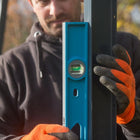Fence Installation Guide - Terminology Explained

Putting up a fence for your home can seem quite daunting, especially if it’s your first time. Not only should you be comfortable in your DIY ability, but it helps to understand the terminology used to describe products and installation methods to ensure all is needed for a smooth-running project.
Here, you’ll find a handy glossary of the most popular fencing terms to help see your project through.
Fence Panels
Fence panels are used to create traditional fencing for a closed off, private place to relax in. Panels come in a variety of sizes, colours, styles and designs including overlap panels, feather edge and picket fences.

Fence Posts
When installing a fence, your fence posts join the panels and are fixed in the ground to provide the support/overall structure to keep it standing. Essentially, the posts you use (and how they’re installed) will determine how strong your fence is.
While fence posts are available in timber, concrete, and metal forms, you should weigh up the pros and cons before deciding what’s best for you.
At Birkdale, we’ve produced the ultimate guide to fence posts to help you with this. Here, we compare the installation times, aesthetics, durability, sustainability and costs of each fence post.

Gate Posts
As suggested in the name, gate posts are used to support the joining of your gate via hinges. Like fence posts, they are fixed in the ground (either using post concrete or spikes) to provide a robust structure.

Corner Posts
Corner posts allow two fence panels to be slotted in at right angles to each other.
[corner post image]
U-channels
The shape of U-channels makes them ideal for fixing post inserts or using as an alternative to concrete posts against walls and other flat surfaces.

Gravel Boards
Positioned underneath your fence panels to protect against moisture, insect, and debris damage, gravel boards are an essential part to most garden fences.
Gravel boards seal any gaps between the ground and your fence, creating a cleaner, more professional look; they can even help increase the height of your fence. In fact, you can even create whole fence panels using gravel boards alone.
You’ll find 3 main types of gravel boards: wood, concrete, and composite, which we compare in our guide to gravel boards.

Post Caps
A wooden or metal cap placed on top of your posts to protect against moisture as well as provide a finished look.

Capping Rails
Similar to post caps, capping rails are used on top of your fence panels for a decorative and protective finish.

Closeboard Fencing
Known for its strength, versatility, and classic design, Closeboard fencing is one of the most popular types of fence panel. This type of fencing is built using vertical, overlapping boards for privacy and stability.

Powder Coating
Powder coating offers a great way to coat metal fencing accessories in pigment and protective polymers without toxic paint solvents. It offers extended durability, corrosion resistance, and an extensive range of colour and finish combinations.

Pressure Treated
Pressure treatment is the process of adding timber to a tank of treatment and then adding pressure to force the preservatives into the product. This helps to extended fence life by protecting against insect, weather, and rot damage.

Galvanised
Galvanisation involves applying a protective Zinc coating over Steel or Iron to prevent rusting. This creates extremely durable fencing that’s both cost-effective and low maintenance. We strongly recommend opting for galvanised products.

Post Concrete
Sometimes referred to as Postcrete, Post Concrete is a ready-mixed concrete solution designed for setting timber, concrete, or metal fence posts. Simply fill post holes with 1/3 water, then pour in your Post Concrete until no standing water is visible. The solution then dries and hardens around your fence post for a secure foundation to your fence.

Post Spikes
A quick and easy way to secure fence posts into the ground. Metal post spikes are driven straight into the ground, with the posts slotting on top. This eliminates the need to dig holes and set your posts in concrete. However, this method of installation doesn’t tend to be as reliable when compared to using post concrete.

Insulated Tools
When erecting a new fence, insulated tools offer safety in the case of striking an electrical cable to prevent injury. Using rubber, fibreglass, or plastic handles, the insulated materials prevent electrical flow passing any further than the metal head.

Looking for fencing terminology we haven’t yet covered? Contact our team of experts at Birkdale today – we’re more than happy to help with any fencing related questions.
DuraPost® fencing systems
Create Extraordinary Spaces
DuraPost® steel fence posts and composite fence panels. Find out why they are the ultimate fencing system.






